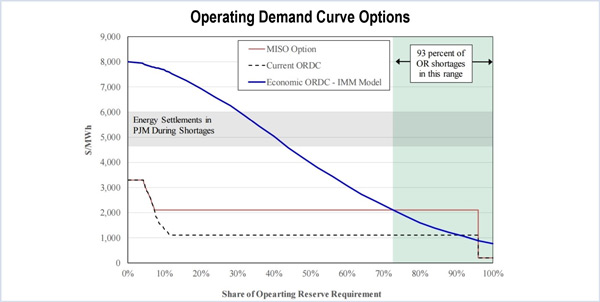By Amanda Durish Cook
MISO’s Independent Market Monitor says the RTO isn’t going far enough in proposing changes to comply with FERC’s new energy offer cap rules.
Chuck Hansen, MISO senior market engineer, told the April 13 Market Subcommittee meeting that the RTO will propose only “minimal” changes to its operating reserve demand curve (ORDC) in a filing planned for next month to comply with FERC Order 831, which requires the use of a $1,000/MWh soft cap and $2,000/MWh hard cap by winter 2017/18. MISO says the ORDC also must be changed because of new NERC reliability rules. (See MISO Contemplates Market Design Changes from FERC Offer Cap Rule.)
Monitor David Patton, however, told the committee that MISO should make broader changes, including an immediate increase in its maximum value of lost load (VoLL) calculation.
MISO’s Step-Based Curve
MISO’s current ORDC is step-based, dropping sharply from a $3,500/MWh maximum VoLL when less than 4% of the requirement level has cleared, to $1,100/MWh when more than 4% of the requirement clears. It then drops vertically to $200/MWh when 96% or more of the requirement is satisfied.
Under MISO’s proposal, the new curve would begin at $3,300/MWh, dropping to $2,100/MWh when the RTO clears 8% of its requirement level, reflective of “extreme scarcity conditions,” Hansen said. At 89%, the level falls to $1,100, remaining there until 96% or more of the requirement is cleared, when the curve flattens at $200.
Even as the top of the ORDC inches toward the maximum VoLL — currently the $3,500/MWh limit set in 2005 — Hansen said MISO won’t recommend VoLL changes in its FERC filing. He acknowledged, however, that the maximum will have to be redone in the “near future.”
“We’re going to move forward with [refreshing the VoLL] subject to budget limits. We’ve got a lot of things going on right now, but assessing VoLL is not a trivial matter,” MISO Executive Director of Market Design Jeff Bladen said.
MISO’s deadline for filing the proposed changes is May 8. “We should be able to achieve that if everything goes as planned,” Hansen said.
Order 831 caps incremental energy offers at the higher of $1,000/MWh or a resource’s cost-based energy offer, with $2,000/MWh being the maximum bid. (See New FERC Rule Will Double RTO Offer Caps.)
MISO said its proposal won the broadest support from stakeholders of four options considered.
Patton Seeks Increase in VoLL
But Patton is recommending the RTO make immediate changes to its VoLL limit and change its ORDC calculation to a sloped curve that he contends would better price shortages. Patton said a VoLL cap of $9,000/MWh is reasonable based on past studies. The Monitor would set a VoLL of $1,000/MWh to reflect the demand curves for spinning reserves and regulation, and high marginal energy costs resulting from congestion.
He pointed to PJM, which currently prices shortages as high as $6,000/MWh (based on the sum of the shortage pricing and capacity performance settlements). If MISO does not increase its VoLL, Patton said, it will result in inefficient imports and exports with PJM when both markets are tight.
Patton says MISO’s proposal fails to address problems with the current curve, which he says overstates the reliability risks for small shortages and understates them for more severe ones. “The steep portion of the ORDC is based on inaccurate loss-of-load estimates” that incorrectly model the loss of only one unit at a time and do not accurately capture wind forecast errors, Patton said.
The Monitor said the curve should reflect the expected VoLL through a calculation of the probability of losing load multiplied by the net value of lost load, resulting in a smoother, more “economic” curve than MISO’s current step-based pricing.
FERC Guidance Needed
Patton said it would be “helpful” if FERC would offer guidance for creating operating demand curves. “They’re set in crude, step-wise curves,” he said. An economic curve will reflect the value of reliability and “allow prices to rise efficiently as operating reserve shortages increase.”
Patton maintains that the current curve’s steep jump between $1,100/MWh and $200/MWh results in “volatile pricing” by offline resources that set prices in extended locational marginal pricing. “The shortage pricing under the economic ORDC will track the escalating risk of losing load,” Patton said. “In the range where most shortages occur, the economic ORDC is sometimes higher and sometimes lower than the current curve so it should not substantially increase consumer costs for these shortages.”
Bladen said there’s “almost certainly improvements to be made” to the ORDC, but MISO first must perform its own studies and move the issue through the stakeholder process before it proposes further improvements.





